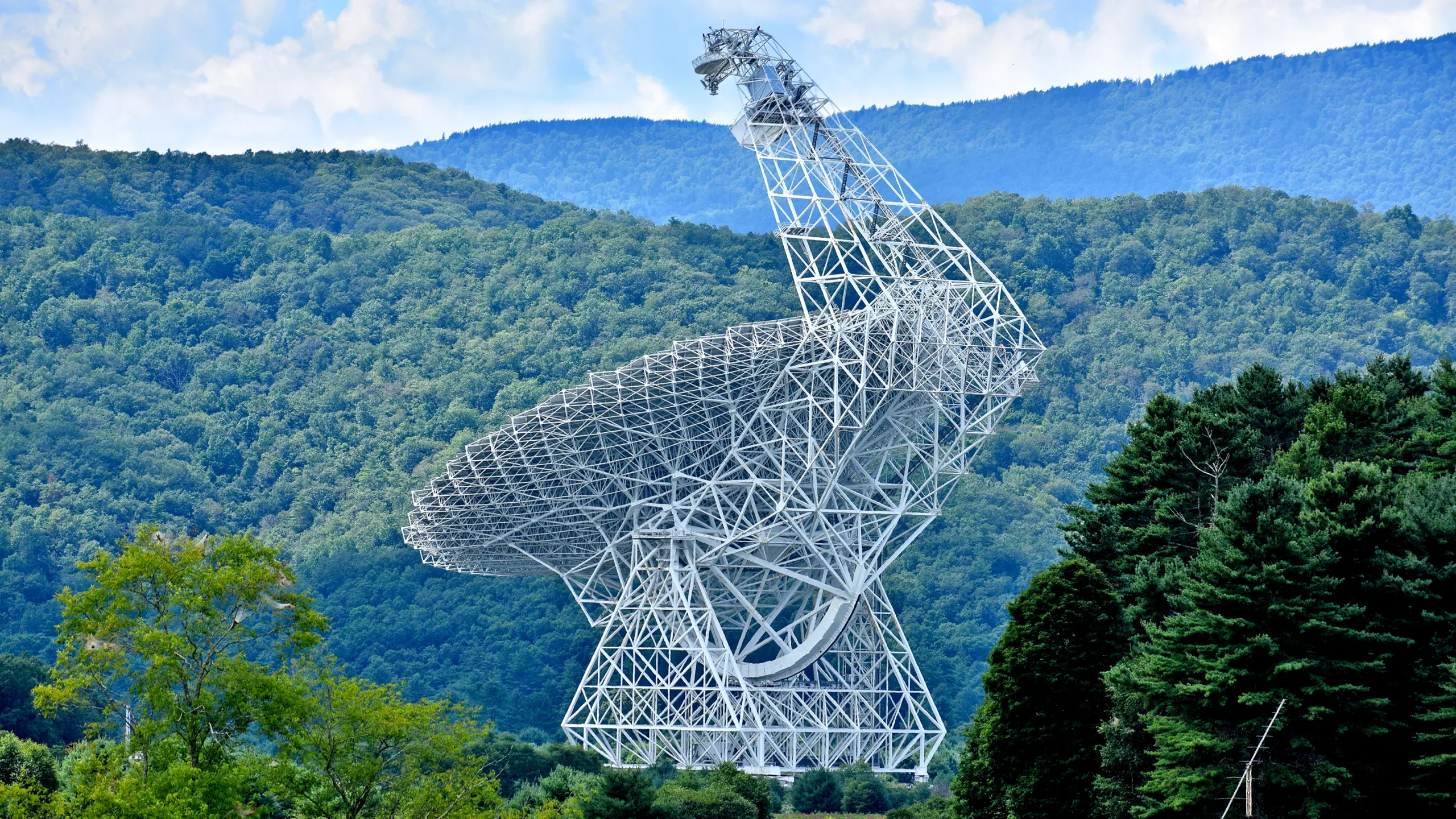An Enormous Gravity ‘Hum’ Moves Through the Universe

The 100-meter Green Bank Telescope has precisely measured the timing of dozens of pulsars over the course of 15 years.
Jim Hoover
Introduction
Astronomers have found an extra-low hum rumbling through the universe.
The discovery, announced today, shows that extra-large ripples in space-time are constantly squashing and changing the shape of space. These gravitational waves are cousins to the echoes from black hole collisions first picked up by the Laser Interferometer Gravitational-Wave Observatory (LIGO) experiment in 2015. But whereas LIGO’s waves might vibrate a few hundred times a second, it might take years or decades for a single one of these gravitational waves to pass by at the speed of light.
The finding has opened a wholly new window on the universe, one that promises to reveal previously hidden phenomena such as the cosmic whirling of black holes that have the mass of billions of suns, or possibly even more exotic (and still hypothetical) celestial specters.
“It’s beautiful,” said Chiara Caprini, a theoretical physicist at the University of Geneva and CERN in Switzerland who was not directly involved in the work. “A new era in the observation of the universe has opened up.”
The results come from studies that stretch back more than a decade by four teams based in the U.S., Europe, Australia and China. Today, in a coordinated data release, the teams present evidence for a background “hum” of gravitational waves that were detected by tracking changes in the impossibly regular beats of objects called pulsars.
As long-wavelength gravitational waves pass through our cosmic neighborhood, they distort the space-time around us, which changes the arrival time of a pulsar’s pulses. Researchers had to map the correlations of these arrival times across dozens of different pulsars for decades in order to pick up the signal. “I had butterflies when I first saw this,” said Stephen Taylor, an astrophysicist at Vanderbilt University and chair of the team known as the North American Nanohertz Observatory for Gravitational Waves, or NANOGrav. “I’m so excited we can finally talk about it.”

The NANOGrav team primarily used three large radio observatories in North America (left to right): the Green Bank Telescope in West Virginia, the Very Large Array in New Mexico and the Arecibo Observatory in Puerto Rico.
Green Bank Observatory; Susan E. Degginger/Science Source; David Parker/Science Source
Most likely, the gravitational waves come from pairs of supermassive black holes that are spiraling around each other inside merging galaxies. But we might be seeing something else entirely, perhaps something exotic such as ruptures in space-time itself resulting from loops of energy called cosmic strings.
“Finding for the first time the suggestion of background gravitational waves is fascinating,” said Juan García-Bellido, a theoretical cosmologist from the Autonomous University of Madrid who was not involved in the work. “It’s really Nobel Prize-winning research.”
A Galaxy-Size Hack
There’s two ways to start the story of this discovery. The first, as usual, is with Albert Einstein. His general theory of relativity in 1915 suggested that the universe is an ocean of space-time on which objects like black holes and stars sit. Movements of these objects would send ripples across this space-time ocean — gravitational waves.
The other place to start the story is in 1967, with a graduate student from Lurgan, Northern Ireland, named Jocelyn Bell. Using a radio telescope that she helped build near Cambridge, U.K., she spotted an unusual signal in space that repeated every second. She and other astronomers later classified these signals as a new class of celestial object known as pulsars — the rapidly spinning cores of dead stars. Today, some are known to spin exceedingly fast, emitting regular pulses of radio waves hundreds or even thousands of times per second.
The stopwatch-like regularity of pulsars makes them valuable cosmic timekeepers. In 1983, the U.S. astronomers Ron Hellings and George Downs suggested a novel way to put them to use: If gravitational waves were squeezing and stretching space-time, that motion would change the arrival time of the pulsars’ radio flashes.
The key is to look at many pairs of pulsars and compare their time delays. “If they’re close together on the sky, they’re both going to be early or late,” said Sarah Vigeland, an astrophysicist at the University of Wisconsin, Milwaukee and chair of NANOGrav’s Gravitational Wave Detection Working Group. “As you pull them apart, they become out of sync, but in a way you can predict.”
Merrill Sherman/Quanta Magazine; source: nanograv.org
To catch these fluctuations, pulsar timing arrays such as NANOGrav use multiple radio telescopes to observe many pulsars over many years. These projects are cosmic cousins of LIGO and other earthbound observatories that detect gravitational waves by looking for tiny changes in the relative lengths of its two arms.
While LIGO’s arms are each four kilometers long, pulsar timing arrays effectively use the distance from Earth to each pulsar as a much larger arm — one hundreds or thousands of light-years in length. “What we’ve essentially done is hack the entire galaxy to make a giant gravitational wave antenna,” Taylor said.
This longer distance makes pulsar timing arrays sensitive to a different variety of gravitational wave. Whereas LIGO can detect high-frequency gravitational waves, which might occur when star-size black holes orbit each other tens or hundreds of times a second before merging, pulsar timing arrays are sensitive to processes occurring across years or even decades. That’s one reason why pulsar timing arrays need many years of data — if it takes a decade for a single wave to pass by, you can’t detect it in just a few months.
Of the four groups releasing data today, NANOGrav is the most confident in its result. The project was founded in 2007 and has largely used the Green Bank Telescope in West Virginia and the Arecibo radio telescope in Puerto Rico (which collapsed in late 2020, near the end of NANOGrav’s 15 years of data collection). “We’re still mourning the loss of Arecibo,” Taylor said.
Separate pulsar timing array projects were also established in different parts of the globe. The four teams, which together form the International Pulsar Timing Array, coordinated today’s announcements, but they have not yet performed a combined data analysis. “It’s complex,” said Andrew Zic, an astronomer at the Commonwealth Scientific and Industrial Research Organization in Australia and part of that country’s Parkes Pulsar Timing Array team. “We’re ready to move towards being a more unified thing.”
In 2020, NANOGrav released preliminary data from 12.5 years of observations. Those showed a tentative hint of gravitational waves affecting the pulses of some 45 pulsars.
Now they’ve added a few more years of data, along with data from nearly two dozen more sources, and a more consistent pattern has emerged. “It really jumps out to us,” Vigeland said.
“We’re looking at deviations in time that are a couple of hundred nanoseconds,” said Scott Ransom, an astronomer at the National Radio Astronomy Observatory and a founding member of NANOGrav. They’ve detected a particular pattern in the data, called the Hellings-Downs curve, that makes them confident that what they’re seeing is the gravitational-wave background. “That’s the smoking gun of gravitational waves.”
The European team, which observed 25 pulsars over 25 years with six telescopes, sees similar hints of timing delays but is less certain of their results. “The Americans are very confident,” said Michael Keith, an astrophysicist at the Jodrell Bank Center for Astrophysics and part of the European team. The Australian team is reporting observations from 32 pulsars over 18 years, while the Chinese team has observed 57 pulsars for a little more than three years.
Supermassive Dances
So what’s causing these waves? The most likely sources are supermassive black holes — behemoths millions to billions of times the mass of our sun. These are found at the center of massive galaxies such as our own Milky Way. When two galaxies collide, as sometimes happens, the supermassive black holes at their centers may also begin to orbit each other, twirling around at a cosmically ponderous rate, and perturbing space-time as they do.
“If you have a rotating distribution of mass that’s not symmetric” — even something small, like a spinning pen — “gravitational waves are coming out,” Keith said. On big enough scales, with supermassive black holes, the low and steady rumble of these waves becomes detectable as they permeate space.

Sarah Vigeland, an astrophysicist at the University of Wisconsin, Milwaukee, and chair of NANOGrav’s Gravitational Wave Detection Working Group, is one of more than 190 researchers working on NANOGrav.
Tonia Klein
NANOGrav can’t yet make out individual gravitational wave sources. Instead, the team has found evidence for the background hum of all low-frequency gravitational waves. It’s like a buoy bouncing up and down in a busy harbor — it can’t distinguish the wake of a single boat, but its motion can reveal that there are some big objects slicing through the water.
Supermassive black holes, however, are not the only possible explanation for the background hum. Another possibility is cosmic strings. First predicted in the 1970s, these would essentially be cracks in space-time caused by the expansion of the universe. The cracks would emit gravitational waves as they spun around in loops.
“The idea of cosmic strings is you have some extension of the Standard Model [of particle physics] in which, in addition to pointlike particles, you can get strings of energy stretching out across the universe,” said John Ellis, a theoretical physicist at King’s College London and CERN who is a proponent of cosmic strings. “Those strings of energy move around and can collide, spawning loops of string that eventually collapse by emitting gravitational waves.”
While the idea is somewhat extravagant, the observations so far from NANOGrav and the other teams are consistent with what we’d expect to see from cosmic strings. “They’d be constantly wriggling, and from time to time they crack like a whip and send out gravitational wave bursts,” said Patrick Brady, an astrophysicist at the University of Wisconsin, Milwaukee. If the pulsar timing arrays don’t see individual sources start to emerge from their upcoming data, that could point toward this exotic physics beyond the Standard Model. “Cosmic strings will give you a much smoother signal,” Ellis said.
But while strings and other exotic phenomena can’t be ruled out, for now supermassive black holes are the favored explanation. “From an Occam’s razor point of view, we know galaxies merge and almost all galaxies have supermassive black holes,” Ransom said. “So we think it’s probably most likely that the signal we’re seeing is from supermassive black holes. But we could be wrong.”
Discovering a population of supermassive black hole pairs would help answer open questions in astrophysics. For example, what happens when two orbiting supermassive black holes get relatively close to each other? There were reasons to think that instead of merging, as smaller black holes do, supermassive black holes just rotate around each other forever. “This is called the last-parsec problem,” Caprini said; a parsec is a unit of distance measuring 3.26 light-years across. “It is an unsolved problem.” If pulsar timing arrays are seeing gravitational waves from these moments, however, it would be “a demonstration that two supermassive black holes do get close enough and merge,” rather than remaining in distant orbits, Caprini said.
Just the existence of such a population has broad implications for our understanding of galactic evolution in the universe. “It would mean that at the center of some galaxies, there are massive black holes that are not just alone,” Caprini said. “We can probe, through the history of the universe, how galaxies collide and the rate of collisions.”
Such work would require the discovery of individual supermassive black hole pairs, and so is not yet feasible. But as researchers combine the data sets from the different teams and take more observations over the next few years, individual sources may start to emerge, perhaps allowing astronomers to pinpoint binary supermassive black holes in space and time.
“Bright individual sources will start poking above this background hum,” said Maura McLaughlin, an astrophysicist at West Virginia University and one of the founding members of NANOGrav. “We’ll be able to say, in that direction, there is a supermassive black hole binary with [a certain] mass. We’ll learn a whole lot about galaxy mergers.”
What is clear is that these projects have given astronomers a completely new tool with which to study the cosmos. The rise of gravitational-wave astronomy “is like when Galileo first turned his telescope on the sky,” Brady said. We now know that a background of ripples in space-time pervades the universe. An ocean of gravitational waves awaits.



